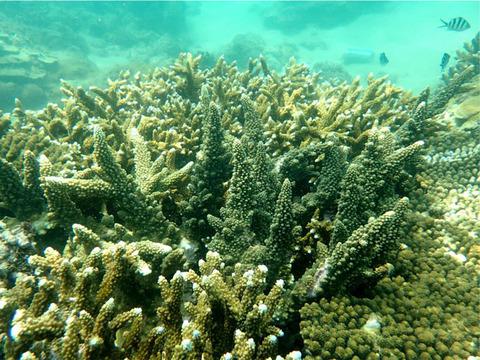当前位置:
X-MOL 学术
›
Ecol. Evol.
›
论文详情
Our official English website, www.x-mol.net, welcomes your
feedback! (Note: you will need to create a separate account there.)
Microstructural characteristics of the stony coral genus Acropora useful to coral reef paleoecology and modern conservation
Ecology and Evolution ( IF 2.3 ) Pub Date : 2021-03-09 , DOI: 10.1002/ece3.7247 Meixia Zhao 1, 2 , Haiyang Zhang 1, 2, 3 , Yu Zhong 2, 4 , Xiaofeng Xu 1, 2, 3 , Hongqiang Yan 1, 2 , Gang Li 1, 2 , Wen Yan 1, 2, 3
Ecology and Evolution ( IF 2.3 ) Pub Date : 2021-03-09 , DOI: 10.1002/ece3.7247 Meixia Zhao 1, 2 , Haiyang Zhang 1, 2, 3 , Yu Zhong 2, 4 , Xiaofeng Xu 1, 2, 3 , Hongqiang Yan 1, 2 , Gang Li 1, 2 , Wen Yan 1, 2, 3
Affiliation

|
Identification of fossil corals is often limited due to poor preservation of external skeleton morphology, especially in the genus Acropora which is widespread across the Indo‐Pacific. Based on skeleton characteristics from thin section, we here develop a link between the internal skeleton structure and external morphology. Ten characteristics were summarized to distinguish Acropora and five related genera, including the type and differentiation of corallites, the skeleton nature of corallites (septa, columellae, dissepiments, wall), and calcification centers within septa. Acropora is distinctive for its dimorphic corallites: axial and radial. Isopora is similar to Acropora but possess more than a single axial corallites. Montipora and Astreopora (family Acroporidae) have monomorphic corallites and a synapticular ring wall, with clustered calcification center in the former and medial lines in the latter. Pocillopora and Porties are classified by distinctive dissepiments, columellae and septa. These microstructural skeleton characteristics were effective in the genus identification of fossil corals from drilled cores in the South China Sea. Eighteen detailed characteristics (ten of axial corallites, four of radial corallites, and four of coenosteum) were used in the Acropora species classification. The axial corallites size and structure (including corallite diameter, synapticular rings, and septa), the septa of radial corallites, and the arrangement of coenosteum were critical indicators for species identification. This identification guide can help paleoenvironmental and paleoecological analyses and modern coral reef conservation and restoration.
中文翻译:

鹿角石珊瑚属的微观结构特征对珊瑚礁古生态学和现代保护有用
由于外部骨骼形态保存不佳,化石珊瑚的鉴定通常受到限制,特别是在印度洋-太平洋地区广泛分布的鹿角珊瑚属。根据薄片的骨架特征,我们建立了内部骨架结构和外部形态之间的联系。总结了区分鹿角珊瑚和五个相关属的十个特征,包括珊瑚的类型和分化、珊瑚的骨架性质(隔膜、柱状、隔膜、壁)以及隔膜内的钙化中心。鹿角珊瑚以其二形性珊瑚礁而闻名:轴向珊瑚礁和径向珊瑚礁。等孢珊瑚与鹿角珊瑚相似,但拥有多个单一的轴珊瑚。 Montipora和Astreopora (顶孔珊瑚科)具有单形珊瑚和突触环壁,前者具有簇状钙化中心,后者具有内侧线。 Pocillopora和Porties按独特的鳞片、小柱和隔膜分类。这些微结构骨架特征对于南海钻探岩芯中珊瑚化石的属鉴定是有效的。鹿角珊瑚物种分类中使用了 18 个详细特征(10 个轴向珊瑚、4 个径向珊瑚和 4 个腔珊瑚)。轴向珊瑚的大小和结构(包括珊瑚直径、突触环和隔膜)、径向珊瑚的隔膜和腔骨的排列是物种鉴定的关键指标。 该识别指南可以帮助古环境和古生态分析以及现代珊瑚礁保护和恢复。
更新日期:2021-04-04
中文翻译:

鹿角石珊瑚属的微观结构特征对珊瑚礁古生态学和现代保护有用
由于外部骨骼形态保存不佳,化石珊瑚的鉴定通常受到限制,特别是在印度洋-太平洋地区广泛分布的鹿角珊瑚属。根据薄片的骨架特征,我们建立了内部骨架结构和外部形态之间的联系。总结了区分鹿角珊瑚和五个相关属的十个特征,包括珊瑚的类型和分化、珊瑚的骨架性质(隔膜、柱状、隔膜、壁)以及隔膜内的钙化中心。鹿角珊瑚以其二形性珊瑚礁而闻名:轴向珊瑚礁和径向珊瑚礁。等孢珊瑚与鹿角珊瑚相似,但拥有多个单一的轴珊瑚。 Montipora和Astreopora (顶孔珊瑚科)具有单形珊瑚和突触环壁,前者具有簇状钙化中心,后者具有内侧线。 Pocillopora和Porties按独特的鳞片、小柱和隔膜分类。这些微结构骨架特征对于南海钻探岩芯中珊瑚化石的属鉴定是有效的。鹿角珊瑚物种分类中使用了 18 个详细特征(10 个轴向珊瑚、4 个径向珊瑚和 4 个腔珊瑚)。轴向珊瑚的大小和结构(包括珊瑚直径、突触环和隔膜)、径向珊瑚的隔膜和腔骨的排列是物种鉴定的关键指标。 该识别指南可以帮助古环境和古生态分析以及现代珊瑚礁保护和恢复。











































 京公网安备 11010802027423号
京公网安备 11010802027423号